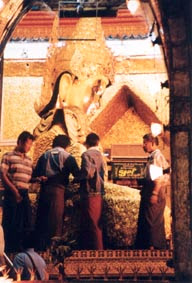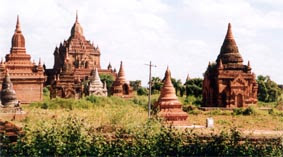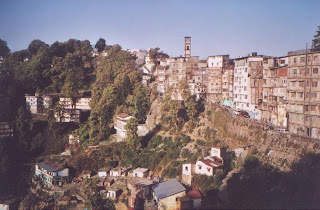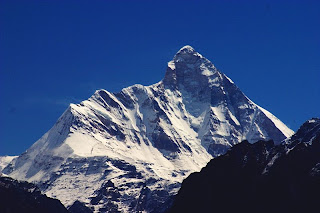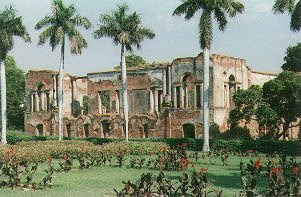We arrived at Calcutta airport in the middle of the night. Bubu, our Indian guide, was there to meet us. Four backpacks and six people were stuffed into ONE taxi. The first impression of Calcutta is rows and rows of people sleeping on the pavement. We slept a few hours and did a little exploring of Calcutta. In the evening we crossed the famous Howrah bridge and spent some time waiting for the train on Howrah station. An incredible place, people sleeping, sitting everywhere. Little children on their own, lying on the pavement.
NRUSINGHANATH
After a long night in the train we met our cook and chauffeur. Drove a few hours and stopped to take a shower and eat something in a hotel. In the afternoon we arrived at Nrusinghanath. We are staying in a very basic building. We spent the evening in the temple. Had dinner there and talked to the priests and sadhus. Bubu was our translator. They made music for us and we sang our National hymn. They seemed to like it. They nodded when we told we had to spent 10 hours in a plane to arrive in India. I doubt they understood, they never travel further away than the next village. They definitely were not able to understand we have no personal teacher, someone who teaches you the meaning of life. In their vision it's not possible to have no religion. Two so different worlds gathered in the yard of a temple.
HARISHANKAR, BHAWANIPATNA
I'm sitting under a tree, next to a small waterfall. Surrounded by about 30 monkeys and 20 men staring at me. Omez is cooking our lunch, The water for cooking comes straight from the river. Ok, we'll survive, I hope. He makes a delicious chai. We eat a lot of tomatoes, spiced with garlic and ginger. After lunch we met a few people of the Mahima Alekh group. They grow their hair, they dress in pieces of bark and their only form of transport are their feet (I saw one on the back of a bicycle, well this is India). We're sleeping in a real guest house tonight. We had dinner in a restaurant with a tablecloth made of old newspapers.
JEYPUR
Before we left this morning we made a walk through Bhawanipatna, a pleasant little town. We had a good day of travel. Made our first stop in a village which was never visited by tourists. We stopped at the beginning of the village and got out of our minibus, after 200 meters we were surrounded by the whole population. When we did one step the crowd gave way like the Red sea. There was a nice little market. The colors of the vegetables are beautiful, as are the colors of the sari's the women are wearing. Back on the road again we saw a tribal altar. They had offered a goat, much to the joy of the ants. In the afternoon Bubu took us to an ashram and we had an interesting conversation with a guru. The man is able to stand on his head for six hours. He was very glad with the reading glasses Pim and Niekje gave him.
ANKADELI
We left this morning for Ankadeli, nearby was a village with a tribal market. Once a week the tribal people, Bonda's, come down the hills to the village to sell their home made alcohol. They drink like crazy. We had to travel with a policeman because of the trouble the Bonda men are causing sometimes when they are drunk. Although the men don't wear the original dress anymore they still carry the bow and arrow. The women are beautiful in their colorful necklaces. Bubu bought a bowl of alcohol and served it to the people, we drank together and the atmosphere was pleasant enough to make some pictures (they do not always like that). We had lunch in the village, a few vegetables, potato's, and the head of a fish with big teeth in it. I skipped the fish. After that a walk to a waterfall. At first we protested, we were too tired for a long walk, but the reward was great. After a rest at the waterfall a walk through the rice paddy's up to our knees in the mud, but Bubu was right again we arrived in a little village with beautiful children. A very old man and woman sang a song for us, good voices despite the alcohol and big cigars. It was kind of moving, sitting under a big tree, hearing these people sing, sharing a drink of alcohol and some corncobs with them. Our worlds are so different.
We are staying in an inspection bungalow, a legacy of the British government. We are not allowed outside at night because of the bears. What bothers me more are the big spiders. We had a nice night with Omez en Nadjir singing and playing. I laughed till tears were running out of my eyes.
GUPTESWAR
 On our way to Gupteswar wise proverbs along the road. Visited a cave and a temple. It's a bit strange to see Bubu paying respect to the gods. In his way of living he is so modern, but in his thinking he is still a brahman. This evening we talked about the differences between our countries, about life and death, marriage, health care, religion. I learn a lot about India thanks to Bubu.
On our way to Gupteswar wise proverbs along the road. Visited a cave and a temple. It's a bit strange to see Bubu paying respect to the gods. In his way of living he is so modern, but in his thinking he is still a brahman. This evening we talked about the differences between our countries, about life and death, marriage, health care, religion. I learn a lot about India thanks to Bubu. India feels good again, it makes me realize what is really important in life.
We are staying in a kind of Inspection bungalow again. No electricity, no water, but we have the river to take a bath. There is one room with a lot of beds, but Bubu is sleeping in his tent, Nadjir in the bus and Omez on the floor in the hallway. Omez doesn't smoke when Bubu is around, it's impolite to smoke in the company of your boss. This morning we all got a flower from Nadjir and Omez. They have a little surprise for us every day.
VILLAGE WITHOUT A NAME
We drove to a village were a fairly developed tribe is living. They are dominated by a few "untouchables" who are clearly the rich people of the village. We are invited for tea and dinner, so we will go back there later in the day. We have lunch on a hilltop, beautiful view. A few locals guide us to the next village. A poor one, very dirty and a lot of dirty pigs walking around. Once part of the village was converted to christianity. There is not much left of the church, but there is an advantage: they celebrate christian AND tribal festivals, double fun. The tribal people have a darker skin than Hindu's and their hair is curly, they look a lot like aboriginals (they are in fact related). One child is obviously ill, she looks yellow, anemic and dehydrated. I ask Bubu about the health care in this village, there is none, only a tribal doctor. Bubu offers to let the child go to the hospital in a nearby village on his costs (200 Rupee, 5$). There is a discussion with the father of the child, all the village men are joining the conversation. At last we understand the father thinks he has to become a christian when he accepts the offer. Bubu convinces him of the contrary and the necessary arrangements are made.
Pim lets the men take a look through his binoculars, they are surprised by what they see and burst out laughing. We get a drink of alcohol fresh from the palm tree.
Back to the first village, it's getting dark and we are tired and very dirty. We go to a little waterfall to take a bath, fortunately the village people give us a little privacy. We enjoy the water like little children, but by the time we are dressed again in our stinking clothes the sand and mud is all over our bodies again.
The woman who invited us is cooking together with her two nieces. She is a strong woman who laughs a lot, around 45 years old and a widow for 12 years. We sit with them in the kitchen, learn some Orya words. most of the time they speak Orya and we speak Dutch to them. It doesn't matter, in a way we understand each other. It's so safe, secure, warm in this kitchen, I want to stay there forever. We have a nice dinner from a fresh banana leaf, stared at by all the children of the village, an Indian art movie. We give a concert of children songs. They ask for more, how is it possible they like this? They probably think this is the highest form of culture in Holland. We go to an open space in the village and there the music starts, a lot of noise and a lot of rhythm. The drums are tuned by holding them above a fire. The dancing starts and it is inevitable, we have to join. My god, they dance like crazy, the speed is killing and it doesn't seem to stop. It are a kind of row dances, escape is impossible. We lose litres of sweat, my feet are on fire. But...it's great fun. Around twelve Bubu tells them these weak Dutch people have to catch some sleep. The oil lamps are lightened up, so they can watch us while we get into our sleeping bags on the veranda. It's a small space, it's almost impossible to turn around without falling off. Every muscle in my body hurts. It's going to be a long, long night.
BISSAM CUTTACK
At five we woke up. The crowd gathered to see us getting out of our sleeping bags, and the women joined us in our search for a toilet, it happened to be behind the water buffalo. After a cup of chai we have to say goodbye. Our hostess puts her arms around me, I have to swallow a few times. Well we go.
Near a dam in the river we take a bath. We are tired and dirty. The effect of the bath lasts for about 15 minutes. We sleep in the bus even the song "Made in India" isn't able to keep us awake. At the next market Omez buys three chickens, still alive, they disappear under his chair and will be our dinner. We arrive at an inspection bungalow and the idea of a mandi bath makes us lyrical. But Bubu has other plans. Omez is going to cook and we are going to a market. There we discover some T-shirts, what a joy, a clean shirt. We go to a village where the jewellery of the Khonda tribe is made. They make moulds of resin and fill them with a mix of copper, bronze and tin. In this way they make "watches", just to wear them as decoration. They don't need a ticking watch, they live by the rhythm of the earth.
Bubu, Pim and Simonne are going to a Khond village (they were not allowed to enter the village, the atmosphere was aggressive), the rest of us stay at the veranda to read and write in the company of very big beetles.
TAPTAPANI
This morning our very last tribal market. We walk uphill to see the Khond coming down with their merchandise. Their bodies are very muscular and they look unapproachable. They don't like to be photographed. They look beautiful in their "white" clothes. They try to sell as much as possible on their way down, if it doesn't work out they try it again at the platform of the railway station and at last they go to the market. They don't like to be around Hindu's or people of other tribes. A local guide asks me to roll a cigarette for him, he is pleased with the result.
Now we are staying in a very good guest house. We spent a lot of time in the sulphur spring. Even my nails are clean now. Nadjir is listening to my walkman. I think he likes Bach.
During this trip I have seen villages, people and a way of living that are going to disappear. The Indian government is taking the woods away from the tribal people, they pay the women to wear a sari instead of their original clothes. I want to thank Bubu for his way of travelling with us, full of respect for the local people, cautious not to damage their culture and dignity. We called him our carefully, careless Ray Ban yogi.


